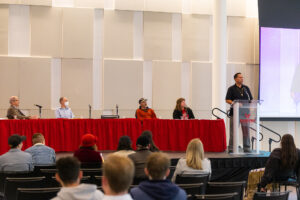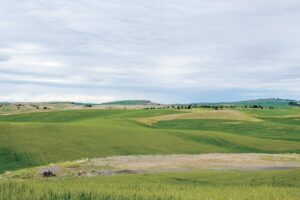EWU Launches New Phase of Major Sustainability Initiative

As the country celebrates Earth Day 2021, Eastern Washington University is excited to launch the next phase of an innovative sustainability effort underway on the Cheney campus. The Prairie Restoration Project will transform 120 acres of university owned land back to its native “Palouse” habitat.
In the days before development and agriculture, the patch of northern Palouse that EWU calls home was part of a magnificent prairie landscape, one that for millennia sustained countless generations of Native peoples. Today almost nothing of the original Palouse prairie remains. Now, in an effort to better serve Eastern students and faculty, as well as the greater community, EWU is embarking on a project to restore the land.
The university is in the midst of a critical, second phase which involves a multi-disciplinary team of faculty, students and staff managing a 1.5-acre plot of lot. The site has been seeded with a biodiverse array of grasses and forbs that once grew in the area. The team is now conducting research to see how the seeds take hold, so the entire project site can be seeded as well.
“This is going to be transformative because our campus is going to have this pretty large area with native biodiversity representing prairie that is becoming pretty rare in this region,” says Rebecca Brown, PhD, EWU professor and chair of the Biology Department. “People can come and see the views and move around through these awesome Palouse hills. I think it’s going to be wonderful.”
Brown points out that some of the best learning at Eastern happens beyond the brick and mortar. The Prairie Restoration Project will create outdoor classrooms, a living laboratory for student research and other hands-on learning experiences. Developed in cooperation with representatives from area Native communities, EWU will create a model for boosting regional biodiversity and provide educational and recreational spaces connecting visitors to a long-lost landscape.
This major university initiative will impact the community for years to come by preserving natural land and providing educational exploration in the following ways:
- Education: The Prairie Restoration Project will expand learning opportunities for students and visitors to campus. The space will inspire outdoor exploration, connections to natural environments, and help develop a strong sense of place.
- Inspiration: With proper education, we hope community members will be inspired to plant native plants in their yards to create their own “pocket prairies.” This simple, actionable step allows supporters to create immediate benefits that will continue for generations.
- Research: Converting the site from wheat cultivation to native grasslands will create many new opportunities for faculty and student research. The living laboratory will provide new opportunities that mimic more real-world situations and prepare students for careers.
- Connection: Many of the plants in the ecosystem are culturally significant to Native Americans for food, medicine, art materials and more. The project will provide renewed access and educational collaboration with local tribes.
- Recreation: A multi-use trail system will provide access to the restoration site and encourage exploration, recreation, and lead visitors to stunning 360-degree views of the region. The community can use the trails to walk, run, mountain bike, cross country ski and observe nature.
- Biodiversity: More than 120 plant species will attract and retain more pollinators in the region and supply nutritional seeds for birds and other small animals. The vast root systems will hold soil in place, reducing the risk of erosion, and draw water down deep into the soil to recharge the groundwater supply.
Please visit Eastern’s new immersive, story-telling website ewu.edu/prairie to explore the work Eastern students and faculty members have already done to prepare and seed the first plots on the site. We also invite you to learn more about how the dramatic environmental impacts this project will have in our community for generations to come.
Filed Under: Prairie Restoration Project
Tagged With: Prairie Restoration Project
Categories
Experts Directory
Find EWU faculty and staff who are experts in diverse subjects.


